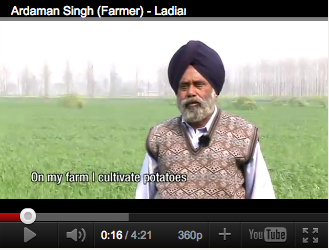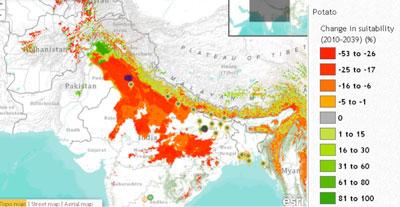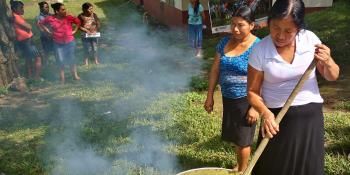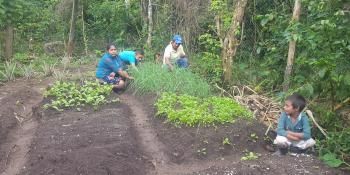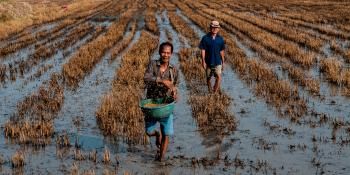Probing the Potato: crop adaptation to climate change
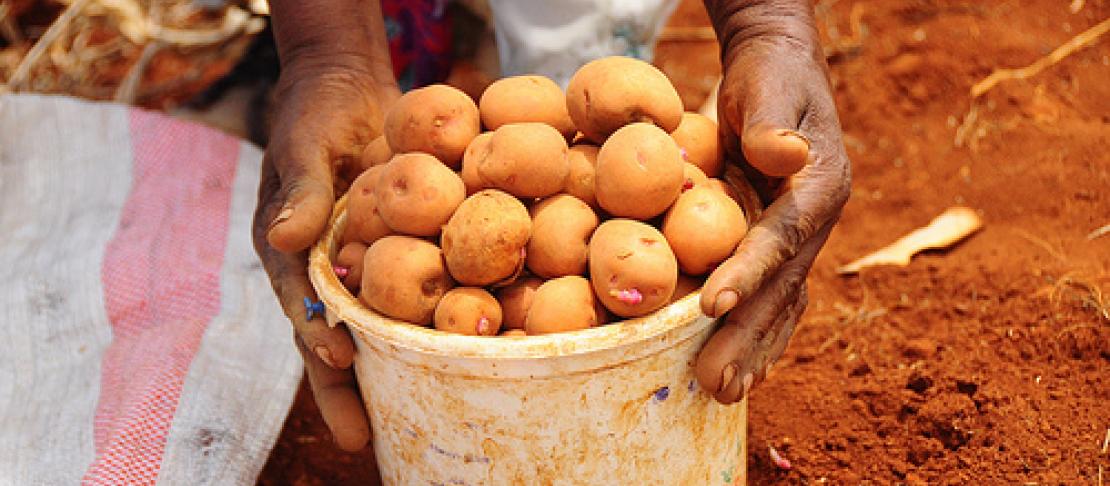
Scientists report that the potato, a dietary staple for millions of people around the world, is especially vulnerable to heat stress which reduces growth and starch formation. See a map of current climate constraints for potatoes worldwide. Rising temperatures in southern Africa and tropical highlands worldwide could be particularly hazardous.
One concern is that climate change could drive the spread of the destructive potato tuber moth northward and to higher elevations. However, some positive effects are also expected in some regions where drier and warmer summers will likely decrease the incidence of potato's worst disease—late blight, which caused Ireland's potato famine in the 19th century. View a map of current climate constraints of Potatoes in India, Asia and the Himalayas.
The research comes from new studies on "climate proofing" key crops across the tropics. The studies by the CGIAR Research Program on Climate Change, Agriculture and Food Security (CCAFS) highlight how climate change will impact crops that are critical to food security in the developing world, and what adaptation strategies can help reduce these impacts.
You can now explore the data behind the studies together with photos and videos of farmers in the affected regions on the newly launched Adaptation and Mitigation Knowledge Network. This platform brings information from diverse sources onto an interactive map, to help build a rich understanding of the issues and impacts.
View from the Punjab: from climate threat to adaptation solution
Ardaman Singh is a farmer in Ladiankalan village in Punjab region. He and his fellow farmers who grow potatoes are already suffering important climatic stresses:
"Over the past five years, there's been a lot of change in the weather. Before, there was sufficient rain but now we have less. The intensity of the rain has increased a lot too. Once the rains come, the water level goes up, but it is not long before it drops again." Watch an interview with Ardaman.
Over the past years, temperatures have changed. They are now higher during the summer and lower during the winter, which is bad news for the crops.
To deal with those challenges, Ardaman's community has adopted several adaptation strategies:
"To get water, we have drill a borehole of up to 30 feet deep... We've now leveled the land to save the water. Before when the land was uneven the water was not evenly distributed. Now the land is leveled up to within one inch so the whole acreage gets evenly watered..We adapted to these changes using irrigation".
To face the expected decrease in climatic suitability for potatoes in the region, Ardaman and his fellow farmers will need to have access to means that help them increase their adaptive capacity. Scientists in the CCAFS program are evaluating different management practices and technologies that could ensure that farmer become more resilient to such changes.
For example, researchers believe developing and distributing heat-tolerant potato varieties could reduce climate-related damage for about 65 percent (7.7 million hectares) of the world's potato crop.Traditional varieties and crop wild relatives could play a vital role in helping farmers adapt to climate change, despite the challenges of crossing species that are distantly related.
Updated continually with new data, the Adaptation and Mitigation Knowledge Network is an initiative of CCAFS that draws on information from the CGIAR centers and partners. This story was written with contributions from Flora Mer, Osana Bonilla-Findji, and Nathan Russell (CIAT).
